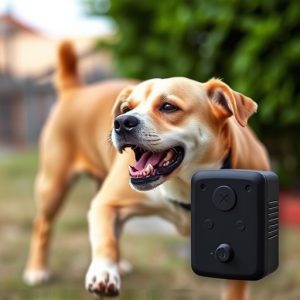Electronic Bark Control: Safety, Range, and Regulatory Compliance
Electronic pet deterrents, adhering to Electronic Pet Deterrent Safety Regulations, offer humane sol…….
Electronic pet deterrents, adhering to Electronic Pet Deterrent Safety Regulations, offer humane solutions for managing dog barking. Reputable manufacturers prioritize pet well-being through advanced sensors, adjustable sensitivity levels, remote controls, and automatic shut-off mechanisms, ensuring effective training without harm. Choosing the right range (10-25 feet for densely populated areas, up to 100 feet for open spaces) is crucial for effectiveness and compliance with local regulations like FCC and RED guidelines.
“Discover the power of bark control devices with multiple ranges, a game-changer in pet training. This article explores the effectiveness and safety of electronic pet deterrents, delving into their inner workings and regulatory considerations. From understanding safety features to navigating compliance across different ranges, we guide you in choosing the optimal setting for your furry friend. By implementing these insights, pet owners can ensure effective bark management while adhering to crucial regulations, fostering a harmonious living environment.”
- Understanding Electronic Pet Deterrents: How They Work and Their Safety Features
- Regulatory Considerations for Bark Control Devices: Ensuring Compliance Across Ranges
- Choosing the Right Range: Customizing Your Bark Control Device for Optimal Effectiveness and Safety
Understanding Electronic Pet Deterrents: How They Work and Their Safety Features
Electronic pet deterrents, also known as bark control devices, are innovative solutions designed to address unwanted pet behaviors, particularly excessive barking in dogs. These devices operate by emitting a high-frequency sound or spray when a pet barks, effectively distracting them and encouraging calmer behavior. The technology behind these deterrents has evolved significantly, incorporating advanced sensors and safety features to ensure effective training without causing harm.
Safety is a paramount concern when considering electronic pet deterrents. Reputable manufacturers adhere to strict Electronic Pet Deterrent Safety Regulations, ensuring that their products are humane and well-regulated. These regulations mandate specific safety measures, such as adjustable sensitivity levels to cater to different pets’ needs and remote controls for user convenience and precision. Additionally, many devices feature automatic shut-off mechanisms to prevent overuse, ensuring the well-being of your pet.
Regulatory Considerations for Bark Control Devices: Ensuring Compliance Across Ranges
When it comes to electronic pet deterrents like bark control devices with multiple ranges, understanding and adhering to safety regulations is paramount. Different regions have distinct standards for such products, focusing on both their effectiveness as a deterrent and user safety. These regulations cover aspects like maximum sound levels, operational frequency bands, and physical design to minimize harm to animals and humans alike.
For instance, the Federal Communications Commission (FCC) in the United States sets guidelines for radio frequency devices, ensuring that bark control devices operate within legal limits. Similarly, European Union directives such as the Radio Equipment Directive (RED) govern electromagnetic compatibility and safety for electronic equipment, including pet deterrents. Staying compliant involves thorough testing and certification to ensure the device’s safety and effectiveness across its intended ranges.
Choosing the Right Range: Customizing Your Bark Control Device for Optimal Effectiveness and Safety
Choosing the right range for your bark control device is crucial for ensuring optimal effectiveness and adhering to electronic pet deterrent safety regulations. It’s important to consider both the environment and the intended use. For instance, if you live in a dense neighborhood with close neighbors, a lower range setting (typically 10-25 feet) can prevent unnecessary activation from distant barks. This not only respects your community but also ensures the device operates within legal boundaries.
On the other hand, if you reside in a more open area or want to protect a larger space like a backyard, selecting a higher range (up to 100 feet) could be more suitable. This allows for better coverage and reduces false triggers from distant animals. Always check local electronic pet deterrent safety regulations to ensure your chosen range complies with laws aimed at preventing animal distress or harm.
When selecting a bark control device, understanding its electronic pet deterrent safety regulations and choosing the right range are paramount. By customizing the device’s settings for optimal effectiveness and adhering to regulatory considerations, pet owners can ensure safe, effective training without causing harm. In light of the above discussions, it’s clear that the key to successful bark management lies in informed decision-making regarding these aspects.


